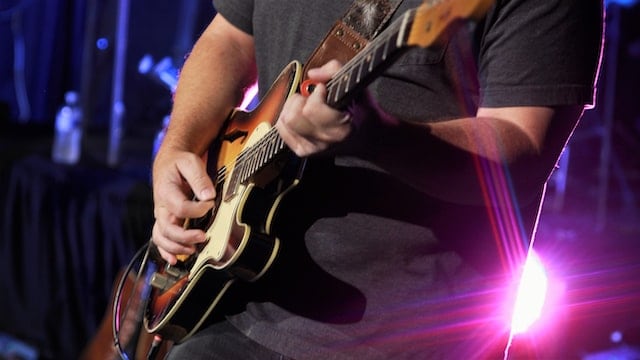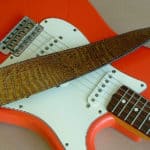Whether you’ve taken lessons or are self-taught, most likely you have spent a lot of your time playing guitar while sitting down.
And there’s nothing wrong with that… until you are about to play a live show for the first time.
If you need to transition from sitting to standing while playing guitar it’s not that hard. Observe some of your favorite musicians performing live and then start practicing… a lot. Be sure to have a comfortable strap and long guitar cable too. And being mindful of your surroundings will pay dividends.
Now it’s totally acceptable to sit down and play in a live situation for styles such as Classical, Jazz, and some Blues.
But for everything else, it’s time to get off your butt.
Here are some ways to go from being a bedroom player to sweating on stage, even if it’s just at a local bar or talent show.
Learning to play guitar standing up in a month
I think this will be much easier to approach if we set up a faux but very likely scenario first.
This should be familiar to some of you and is based on personal experience.
So let’s say that you have mostly played by yourself while sitting down and though you have messed around playing with friends you were usually seated then too.
Now one of your friends has asked you to join a band or fill in for someone who is sick or something.
There is a set list of about 10 songs that you will be performing.
None of the songs are particularly hard, mostly just rhythm guitar stuff and no backing vocals to worry about.
But your first live show is a month away.
What should you do to become comfortable playing guitar while standing up and not look super awkward in front of the audience?
Focus on the following 3 tips:
1. Look at other players
First I think you should check out some live footage of your favorite guitar players in the same genre as you will be performing.
Look at what height their instrument is at on their body and whether the guitar rests horizontally or at an angle with the headstock higher than the guitar’s body.
Do they stand still or move around a lot?
Remember this isn’t just about technique; it’s also about style.
Check out their strap and see if they use strap locks or have any special trick to keep their cable from getting pulled out of the guitar such as tape or looping it through the strap.
Do they stand squarely or is one leg slightly in front of the other and which leg is their weight resting on?
How long is their instrument cable and do you need to purchase a longer one for playing live?
All of these observations should help you as you develop a practice routine to get ready.
2. Practice standing up
Here are some ways that you should be spending your precious time as you prepare for your debut show.
When you first begin learning guitar I think it’s natural to hunch over your instrument a little as you try to see where your fingers need to be on the fretboard.
Even seasoned players may do this when they learn a new song.
But it doesn’t look so good to be staring at the neck of the guitar the whole time when you’re on stage.
So practice every song on the set list until you rarely have to look at your fretting hand.
And if you have to do a solo, I think it’s okay to look and it’s almost expected that you do so as you make emotional faces like you can’t believe what’s happening.
And of course, you need to be practicing while standing up most of the time.
Maybe walk around a little and play in front of a mirror to see how you look.
Lower or turn off the lights to get used to playing in dim or dark atmospheres, anything to replicate what playing on stage will be like.
And when your legs or back need a break but you want to keep on practicing, sit down but play with the guitar strap on.
If your standing style is to hold the instrument higher on your body than it is when you are sitting and resting it on your leg, use the strap to match that guitar’s height and angle when sitting.
Make sure your strap will be comfortable on your shoulder for a long period and purchase a new one if needed.
And practicing a lot isn’t just for your body and posture but to build your confidence so you won’t be anxious about playing in front of an audience.
3. Be aware of your surrondings
When the big day finally arrives, you will probably have a lot on your mind.
Since you won’t be safely sitting down, you really need to be aware of your surroundings so make a mental map of the stage where you will be playing.
Take note of any obstacles on the ground such as cables, pedal boards, floor monitor speakers (don’t be a jerk and put your foot up on the venue’s monitor speakers), and where your bandmates will be.
Seriously, even professional performers fall off stages more than you might think.
Also, figure out your movement range according to the length of your instrument cable, and make sure you calculate in some slack to spare.
Finally, if you have put in the necessary blood, sweat, and tears, performing should be a breeze.
I’ll see you on tour… think you can put me on the guest list?

Hello there, my name is Ramiro and I’ve been playing guitar for almost 20 years. I’m obsessed with everything gear-related and I thought it might be worth sharing it. From guitars, pedals, amps, and synths to studio gear and production tips, I hope you find what I post here useful, and I’ll try my best to keep it entertaining also.





